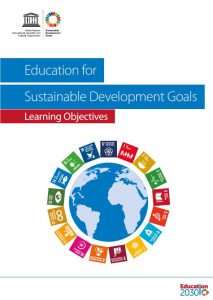“To create a more sustainable world and to engage with issues related to sustainability as described in the Sustainable Development Goals (SDGs), individuals must become sustainability change-makers. They require the knowledge, skills, values and attitudes that empower them to contribute to sustainable development. Education is thus crucial for the achievement of sustainable development, and Education for Sustainable Development is particularly needed because it empowers learners to take informed decisions and act responsibly for environmental integrity, economic viability and a just society, for present and future generations.”
The publication intends to guide readers on how to use education, and in particular, Education for Sustainable Development (ESD), in achieving the SDGs. It identifies learning objectives, suggests topics and learning activities for each SDG, and describes implementation on diferent levels from course design to national strategies.
The core part of this document:
- summarises the key competencies for learners to develop in ESD and,
- outlines indicative learning objectives, topics and pedagogical approaches for each of the 17 SDGs.
- subsequently, a shorter section provides guidance on implementation at different educational levels and in various settings
…………………………….
Contents List
Introduction
The sustainable development goals – an ambitious and universal agenda to transform our world
Education for sustainable development – a key instrument to achieve the SDGs
Who is the guidance for and how can it be used?
1. Learning objectives for achieving the SDGs
1.1 Cross-cutting key competencies for achieving all SDGs
1.2 Specific learning objectives for the SDGs
1.2.1 SDG 1 No Poverty
1.2.2 SDG 2 No Hunger
1.2.3 SDG 3 Good Health and Well-being
1.2.4 SDG 4 Quality Education
1.2.5 SDG 5 Gender Equality
1.2.6 SDG 6 Clean Water and Sanitation
1.2.7 SDG 7 Affordable and Clean Energy
1.2.8 SDG 8 Decent Work and Economic Growth
1.2.9 SDG 9 Industry, Innovation and Infrastructure
1.2.10 SDG 10 Reduced Inequalities
1.2.11 SDG 11 Sustainable Cities and Communities
1.2.12 SDG 12 Responsible Consumption and Production
1.2.13 SDG 13 Climate Action
1.2.14 SDG 14 Life below Water
1.2.15 SDG 15 Life on Land
1.2.16 Peace, Justice and Strong Institutions
1.2.17 Partnership for the Goals
2. Implementing learning for the SDGs through ESD
2.1 Integrating ESD in policies, strategies and programmes
2.2 Integrating ESD in curricula and textbooks
2.3 Integrating ESD in teacher education
2.4 Delivering ESD in the classroom and other learning settings
2.5 How to assess ESD learning outcomes in the quality of ESD programmes?
3. Conclusions

